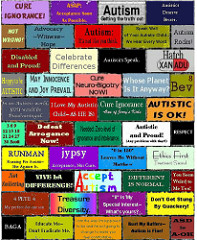Sole Replacement
30 October 2008 at 4:45 (Humor/ Fun Stuff, Wordless Wednesday)
Things that mystify me
29 October 2008 at 2:43 (Critical Thinking, Rants, Skeptic's Circle, Teaching/Tutoring)
Not big, cosmic questions. Little stupid piddly-ass stuff. Like:
People who wedge open the flaps to trash cans by sticking their drink cups partway in. Why not simply push the flap just a bit further in and drop your rubbish into the can? Why leave it wedged open? This makes the OCD-ish part of my brain hurt.
When someone asks, “Why is it always in the last place you look?”
“Because,” I finally replied to my clueless coworker, “once you find it, you quit looking!”
“Oh! I never thought of that.”
(I regret that I am not making this up.)
This was a rant from last week, by one of the secondary teachers: Read the rest of this entry »
How to Swat a Fly
25 October 2008 at 18:30 (Behaviour management, Insects & Arachnids, Science)
Some of this is not breaking news, but some is. When I was watching someone in another classroom in futile pursuit of said dastardly, dirty diptera, I realised that there is a lot of interesting science behind successful swatting.
Flies are hard to swat for a number of reasons. They avoid predation by both sensory detection and behavioral responses. With its large eyes, a fly can see nearly 360°, including behind itself. This means that it’s nearly impossible to “sneak up” on a fly. Because an insect’s flicker fusion frequency is 250 Hertz or more (compared to the human 50), they are vastly more sensitive to motion. Flies can see a flyswatter coming at them, no matter how slow or fast you move it. As anyone who has ever examined their prey has noted, flies are also hairy. These “hairs” (setae) make them sensitive to changes in ambient air speed and direction — they can feel the acceleration of the air from the pressure wave created by the flyswatter.
Michael Dickinson and others at the California Institute of Technology have recently teased out other details to the flys’ success. They used high-speed imaging to discover that Read the rest of this entry »
Moldy bagels
25 October 2008 at 1:42 (Teaching/Tutoring)
Only teachers get excited by such things as bagels sprouting fluffy fungal mycelial masses. “Oh, boy! Some Rhizopus and Penicillium, just what I needed for this week’s lab exam!”
Yes, I’m in the thick of making up, administering, and grading endless rounds of exams. Both classes have exams every week, and they also have periodic larger exams. As this is the first time I’ve taught either course, I’m up to my tuchis in the exam-writing process, so the whole process keeps me busy as a beehive*.
And of course, every teacher loves to collect those oddball answers to test questions. Here are some from college students studying botany & horticulture (correct answers in parentheses). [N.B. for those concerned with the politically correct, none of these students were identified to me as having dyslexia or other learning issues. However, there’s a good chance that many of us are suffering sleep deprivation.]
List a specific epithet describing the growth habit of a plant:
Palin_short, dwarf (pumila) Read the rest of this entry »
Excuses, excuses
21 October 2008 at 4:57 (Accessibility, Advocacy, Inclusiveness, Invisible disabilities, OMG, Physical impairments, Rants, Work / Employment)
WARNING: THIS POST CONTAINS CUSSING.
If such righteous indignation will damage your precious shell-like ears,
then ye’d best hie off somewhere else.
“Who they hell are you to complain?”
“Everyone else is thrilled to have such crap circumstances.”
“But that’s the way we’ve always done it.”
“We’re treating everyone ‘fairly’ by giving everyone the same crappy environment.”
“Everyone else just sucks up and copes with the crappy environment, or doesn’t use it. You’re just being whiny and asking for special favors if you don’t, too.”
“If you try to modify your crappy environment to make it more usable, then everyone else will want to do that, too, and we can’t have that kind of thing going on.”
Okay, in real life the stupid excuses we get are not phrased so blatantly. There’s usually some kind of artificially-flavoured-and-colored fluffy nonsense-phrasing hiding the real meaning. That, or the excuses aren’t even given directly, but phrased indirectly with dismissive facial expressions, gestures, trite homilies, or vague references to (sometimes nonexistent) business regulations.
Amazing, isn’t it?
Or, perhaps not. Not amazing, because Read the rest of this entry »
Want!
18 October 2008 at 2:41 (Diversity, w00t!, Work / Employment)
Check out this small meeting room (one of a number of diverse, really cool nooks) at the Google offices in Zurich. Unseen in the first shot is the firefighter’s pole to slide down from the floor above! It sure beats the hell outta the industrial-grey cube-farm where I did tech writing. But what’s fabulous about these offices (and other Google buildings) is not just the physical environment, but also the social and business culture that values play and creativity, rather than viewing them as frivolous distractions from “real” work.
There is a world of creative people out there actually making living wages in different businesses, using their knowledge in imaginative, useful and positive ways, and I want in. I feel like a moth beating against the window pane … it’s enough to make one cry.
(But what kind of job does a worker bee with degrees in science, a teaching/special education background — but not a secondary-school teaching certification, and skills in art and communication do?)
Yes, they really are irrational
17 October 2008 at 11:54 (Autism/Asperger's, Cognitive biases)
Or at least, more so.
If you have ever sat on the sidelines thinking to yourself that the humans don’t make sense (to the point that others compared you to the character Spock from Star Trek), there is some research evidence vindicating that perspective.
Professor Ray Dolan’s research group at the Wellcome Trust Centre for Neuroimaging, University College London, have an article in the recent issue of Journal of Neuroscience (link to press release). Using a study to examine the decision-making in autistic and neurotypical subjects, they found that the former were less likely to be swayed by “framing effects” in the opportunity descriptions.
“People with autism tended to be more consistent in their pattern of choices, their greater attention to detail perhaps helping them avoid being swayed by their emotions,” says Dr Neil Harrison.
Although this attention to detail and a reduced influence of emotion during decision making is beneficial in some situations, it may be a handicap in daily life, explains Dr Benedetto De Martino.
“During social interactions a lot of information must be processed simultaneously, making this a very complicated computational task for the brain,” he says. “To solve these complex problems we rely on simplifying heuristics – gut instincts – rather than extensive logical reasoning. However, the price that we seem to pay for this ability is that sometimes irrelevant contextual information leads us to make inconsistent or illogical choices.
“Less reliance on gut instincts by people with autism may underlie their difficulties in social situations, but also enable them to avoid potentially irrelevant emotional information and make more consistent choices.”
As ever, it helps to remember that the benefits or problems associated with skewed skill sets will always be affected by how necessary or valued are those skill sets. The important part is to enable people by arranging their (home, job & school) workloads that will utilise their skills, rather than accentuate their deficits. After all, we all have skills and deficits — some of us have more pronounced skills and/or deficits.
Instant meltdown
16 October 2008 at 22:38 (Meltdowns / Shut-downs, OMG)
It took me three times as long as the average person to learn to drive. I took driver’s education twice. I had to drive automatic transmission for a year before I mastered stick-shift. Despite all this, I did learn, and in later years have successfully driven in both the US and the UK.
But I am SO glad I never saw this while behind the wheel — I would have been so overwhelmed as to want to curl up into a fœtal ball:
The “Traffic Light Tree” is a sculpture by Pierre Vivant, in London’s Docklands. It’s interesting enough as a visual pun on urban fixtures and London Plane trees, but what insane person decided to forgo the usual park and install such an art piece in the middle of a roundabout?!
Set volume control to “Gravy”
16 October 2008 at 3:38 (Cats, Wordless Wednesday)
Wanted: Planet with longer rotational period
13 October 2008 at 5:02 (ADD/ADHD, Autism/Asperger's, College/University, Sleep, Tourette's / tics, Work / Employment)
It’s not just me. A lot of people whom I know in person or via the internet have complained about near-futility of trying to get to sleep earlier at a “reasonable” time, meaning one that would give a person enough hours of sleep before having to rise for the next day.
My children and I can’t get to sleep before 11 p.m. unless we’ve been hit by dire viruses, or else have simply stayed up the entire night. In contrast, hubby can retire early and then go from laying down to snoring in less than five minutes, and we’re all mystified at how he manages this! Obviously, such a somnolent physiology was not something our children inherited from dad.
While our young adults have endeavoured to find college classes that start later in the morning (not unlike the majority of college students out there), I myself do not have the luxury of that option. I’m expected to be at the school at 7:30, which means leaving at 7:00. (In reality, I need to leave by 7:10, but I keep aiming for 7:00 to give me the necessary buffer in my nutz ADHD distractedness.) Given the zombie-like staggering arthritic stiffness and mental sluggishness of my morning routine, I need to roll out of bed at 6. Now that really isn’t an unusual time for working folks to get up, but my problem is that for most of my life I’ve not been able to get to sleep until midnight, even when I’ve put myself to bed by 10 p.m.
Part of that delay was due to the fact that Read the rest of this entry »
That old social bugaboo. Again. Still.
12 October 2008 at 14:09 (Auditory Processing Disorder, Autism/Asperger's, Eye contact, Prosopagnosia, Teaching/Tutoring, Tinnitus)
So, recently I was observed while teaching an evening class, and a couple weeks later had the opportunity to meet and discuss the professor’s observations. Except for one problem, most everything else can easily be resolved.
I was able to explain how the combination of illness and exhaustion were affecting me, as well as how accessory issues like Auditory Processing Disorder and tinnitus and prosopagnosia meant that I had to either work harder or do some things differently. I explained how I took notes during the classes of what I wanted to do differently, to keep improving my teaching. I think that overall the discussion went well.
The prof had some really good suggestions, such as repeating questions, or asking students if I had answered their question. He reminded me not to mutter to myself when looking for something, as it was distracting to the students.
Since the observation, I decided to have the students pick up their returned papers from a pile, instead of trying to pass them out. That had not worked out well. Due to my faceblindness, I was carrying around my seating chart and asking each person if they were so-and-so before handing them their paper. Students can accept that the first week or two of school, but even though I have mentioned my problem more than once, the concept is really hard for most people to get their brains wrapped around.
Halfway into the semester, I’ve finally sorted people out with regards to my prosopagnosic identification crutches, but I’m still working getting the names attached to their individual gestalts. The other week I was entering grades and finally realised that there’s a student who is in both of my classes! That this student is rather generic looking, quiet, and sits in the back of the classroom doesn’t help, faceblindness-wise.
But after the whole review experience had passed beyond the anxiety level into the stage of applying the information positively, I am still sighing over one point.
I thought I had gotten past this. I thought I had it down pat. But apparently, I still need to work on making eye contact.
The sum of good intentions
11 October 2008 at 12:55 (Anti-Quackery, Critical Thinking, Developmental disabilities, Learning Disabilities, Medical Quackery, Politics, Science)
Feel free to insert the more familiar or acceptable word of your choice. But regardless of your word choice, the equation stands:
Good Intentions plus Bullshit still equals Bullshit
It doesn’t matter if you are a parent earnestly trying to help your child improve lagging developmental skills — if the information you are disseminating to newbies or news agencies is based upon bogus treatments and world-wide conspiracy theories, then the information you are giving others is still bullshit. (Example: vaccines cause autism and/or dozens of unproven “cures” for all sorts of developmental/educational difficulties.)
It doesn’t matter if you are an elected official trying to get funding for projects that could potentially improve the local economy — if your cherry-picked “experts” assert that there are no ecological problems, but the overwhelming majority of experts from agencies around the world say there will be serious consequences, then your assertions are still bullshit. (Example: Sarah Palin on global warming, oil pipelines, and polar bears.)
It doesn’t matter if you are a news reporter trying to ensure “balanced coverage” of a story by quoting from “both sides” — when one of those “sides” lacks credibility and just presents distraught protagonists ranting over perceived injustices because fact-based reality keeps intruding upon belief systems based upon magical thinking and millenia-old folk tales, then your editorial judgment is weak and the news is full of bullshit. Respecting others’ feelings and beliefs does not mean that those should usurp sound legislative, educational or economic practices, or be allowed to trump everyone’s civil rights. (Example, Creationism/Intelligent Design being taught in science classes.)
Nope; the earnestness and good intentions part cannot gloss over the huge piles of bullshit. Crap is still crap, and the best thing we can do with crap is to put it with the rest of the dead stuff and compost it, until the bacteria and worms and arthropods have broken it down into something useful.
You can find the coolest things on the Web!
10 October 2008 at 21:56 (Insects & Arachnids, Politics, w00t!)
Source: Democratic Stuff.com (an amazingly wide variety of interest groups are represented, besides Bug Enthusiasts.)
Nevermind Easy Street — I’d settle for just Okay
9 October 2008 at 3:11 (Humor/ Fun Stuff, Wordless Wednesday)














You must be logged in to post a comment.